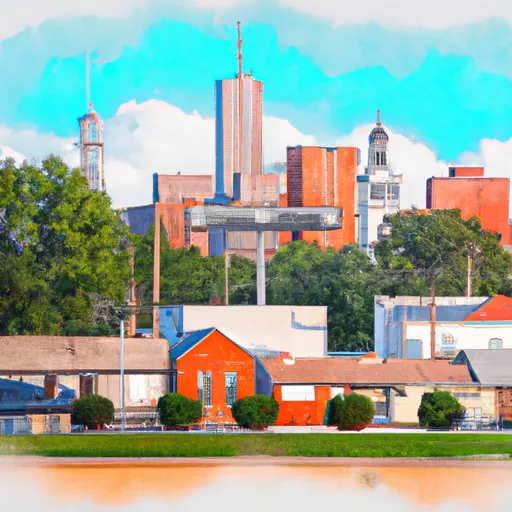-
 Snoflo Premium
Snoflo Premium
Get unlimited access to all our content
With no Ad interruptions! - Start Your Free Trial Login with existing account
New-Baden
Eden Index
Climate
8.3
•
Recreation
3.1
•
Community
3.8
•
Safeguard
5.3/10

New Baden is a small village located in Clinton County, Illinois. The climate of New Baden is considered humid continental, characterized by hot, humid summers and cold winters. Summers are typically warm, with average temperatures reaching around 85°F (29°C), while winters are cold, with temperatures averaging around 32°F (0°C). Precipitation is evenly distributed throughout the year, with around 40 inches (1016 mm) annually.
New Baden is situated near several hydrological constituents, including the Carlyle Lake, which is the largest man-made lake in Illinois. This 26,000-acre lake offers excellent fishing, boating, and swimming opportunities. The Kaskaskia River, a major tributary of the Mississippi River, also flows near New Baden, providing additional recreational activities such as kayaking, canoeing, and wildlife watching.
Outdoor enthusiasts in New Baden have access to numerous recreational opportunities. The village maintains several parks and trails, including the New Baden Community Park and the Clinton County Trails, which are perfect for walking, jogging, and picnicking. Additionally, the nearby Carlyle Lake State Fish and Wildlife Area offers hunting, camping, hiking, and bird-watching opportunities.
In summary, New Baden, Illinois experiences a humid continental climate with hot summers and cold winters. It is surrounded by hydrological constituents like Carlyle Lake and the Kaskaskia River, providing ample opportunities for fishing, boating, and other water-based activities. The village also offers parks, trails, and wildlife areas for outdoor recreation such as hiking, camping, and hunting.
What is the Eden Index?
The Snoflo Eden Index serves as a comprehensive rating system for regions, evaluating their desirability through a holistic assessment of climate health, outdoor recreation opportunities, and natural disaster risk, acknowledging the profound impact of these factors on livability and well-being.
Climate Health Indicator (CHI): 8.3
New-Baden receives approximately
1041mm of rain per year,
with humidity levels near 84%
and air temperatures averaging around
13°C.
New-Baden has a plant hardyness factor of
6, meaning
plants and agriculture in this region thrive during a short period during spring and early summer. Most
plants will die off during the colder winter months.
By considering the ideal temperature range, reliable water supplies, clean air, and stable seasonal rain or snowpacks, the Climate Health Indicator (CHI) underscores the significance of a healthy climate as the foundation for quality living.
A healthy climate is paramount for ensuring a high quality of life and livability in a region, fostering both physical well-being and environmental harmony. This can be characterized by ideal temperatures, reliable access to water supplies, clean air, and consistent seasonal rain or snowpacks.
Weather Forecast
Streamflow Conditions
Kaskaskia
Area Rivers
Kaskaskia
Snowpack Depths
Kaskaskia
Reservoir Storage Capacity
Kaskaskia
Groundwater Levels
Recreational Opportunity Index (ROI): 3.1
The Recreational Opportunity Index (ROI) recognizes the value of outdoor recreational options, such as parks, hiking trails, camping sites, and fishing spots, while acknowledging that climate plays a pivotal role in ensuring the comfort and consistency of these experiences.
Access to outdoor recreational opportunities, encompassing activities such as parks, hiking, camping, and fishing, is crucial for overall well-being, and the climate plays a pivotal role in enabling and enhancing these experiences, ensuring that individuals can engage in nature-based activities comfortably and consistently.
Camping Areas
| Campground | Campsites | Reservations | Toilets | Showers | Elevation |
|---|---|---|---|---|---|
| DLo Water Park | None | 312 ft | |||
| Walkiah Bluff Water Park | None | 38 ft | |||
| Dry Creek Water Park | None | 514 ft | |||
| Okatoma Water Park | None | 396 ft | |||
| Lake Ross Barnett | 22 | 402 ft | |||
| Lake Mike Conner | 20 | 314 ft | |||
| McLeod Water Park | None | 22 ft | |||
| Little Black Creek Waterpark | None | 296 ft | |||
| Simpson County Lake | 11 | 427 ft | |||
| Lake Columbia | 12 | 212 ft |
Nearby Ski Areas
Catastrophe Safeguard Index (CSI):
The Catastrophe Safeguard Index (CSI) recognizes that natural disaster risk, encompassing floods, fires, hurricanes, and tornadoes, can drastically affect safety and the overall appeal of an area.
The level of natural disaster risk in a region significantly affects safety and the overall livability, with climate change amplifying these risks by potentially increasing the frequency and intensity of events like floods, fires, hurricanes, and tornadoes, thereby posing substantial challenges to community resilience and well-being.
Community Resilience Indicator (CRI): 3.8
The Community Resilience Indicator (CRI) recognizes that education, healthcare, and socioeconomics are crucial to the well-being of a region. The CRI acknowledges the profound impact of these elements on residents' overall quality of life. By evaluating educational resources, healthcare accessibility, and economic inclusivity, the index captures the essential aspects that contribute to a thriving community, fostering resident satisfaction, equity, and social cohesion.

